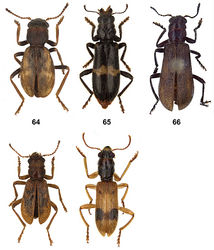Xenorthrius
| Notice: | This page is derived from the original publication listed below, whose author(s) should always be credited. Further contributors may edit and improve the content of this page and, consequently, need to be credited as well (see page history). Any assessment of factual correctness requires a careful review of the original article as well as of subsequent contributions.
If you are uncertain whether your planned contribution is correct or not, we suggest that you use the associated discussion page instead of editing the page directly. This page should be cited as follows (rationale):
Citation formats to copy and paste
BibTeX: @article{Roland2011ZooKeys92, RIS/ Endnote: TY - JOUR Wikipedia/ Citizendium: <ref name="Roland2011ZooKeys92">{{Citation See also the citation download page at the journal. |
Ordo: Coleoptera
Familia: Cleridae
Name
Xenorthrius Gorham, 1892 – Wikispecies link – ZooBank link – Pensoft Profile
Type species:
Xenorthrius mouhoti Gorham, 1892. Gorham 1892[1]: 733, 1893[2]: 575; Schenkling 1903:[3] 46–47.
Distribution:
Indo-Australian and Palaearctic region.
Material examined:
Xenorthrius mouhoti, Lectotype (MSNG), Paralectotypes, and additional species (see Gerstmeier and Eberle 2010[4]).
Description
Head: Eyes strongly protruding, conspicuously emarginate at antennal insertion; interocular space larger than one eye width; gular sutures subparallel to divergent, gular process varying in width, from narrow to broad; antennal length interspecifically variable and sometimes sexually dimorphic (longer in males), A2 shorter than A3, A3-A8 more or less filiform, A10 broader than long, A11 sub-ovate, apical half pinched, mostly without club, sometimes terminal three antennomeres forming a loose club.
Thorax: Proepimeron medium-sized, more or less acute; anterior mesosternal process present, with a subtriangular sulcus in the middle (Fig. 7); metendosternite with normal furcal stalk length, furcal arms broad, apically dilated, stalk base very slightly to deeply emarginate (Fig. 20). Elytra subparallel, sometimes broadest behind middle, apices rounded (most species), strongly dehiscent (Xenorthrius prolongatus and Xenorthrius furcalis), or dentate (Xenorthrius truncatus and Xenorthrius scordalus); elytral punctation arranged into ten striae.
Legs: Mostly relatively short; tarsal pulvillar formula 4-4-4, tibial spur formula 1-2-2; tibiae with or without longitudinal carinae; claws with pronounced basal denticle (Fig. 10).
Abdomen: Apical margin of male ventrite 6 more or less distinctly emarginate (Fig. 57); tegmen mostly elongate, cross-section subrectangular; phallobasic struts not fused, phallic struts acute, phallobasic apodeme not dilated distally (Fig. 46).
Taxon Treatment
- Roland, G; Jonas, E; 2011: Definition and Revision of the Orthrius-group of genera (Coleoptera, Cleridae, Clerinae) ZooKeys, 92: 35-60. doi
Other References
- ↑ Gorham H (1892) Viaggio di Leonardo Fea in Birmania e Vicine. Annali del Museo Civico di Storia Naturale di Genova, Ser. 2a 12 (32):718-746.
- ↑ Gorham H (1893) A list of the Coleoptera, of the family Cleridae, collected by Mr. Doherty in Burmah and Northern India, with descriptions of new species; and of some species from Borneo, Perak, &c., from the collection of Alexander Fry, Esq. Proceedings of the Zoological Society of London 39:566-581.
- ↑ Schenkling S (1903) Coleoptera. Malacodermata. Fam. Cleridae. In: Wytsman P (Ed) Genera Insectorum, Fasc. 13, P. Wytsman, Bruxelles, 124pp.
- ↑ Gerstmeier R, Eberle J (2010) Revision of the Indo-Australian checkered beetle genus Xenorthrius Gorham, 1892 (Coleoptera: Cleridae, Clerinae). Zootaxa 2584:1-121.






